 Beijing (北京) is the capital of the People's Republic of China. It is the political, cultural, domestic and international exchange center of the country and one of the largest historical and cultural cities and ancient capitals in the world. Man first appeared in Beijing 700,000 years ago as evidenced by the primitive Peking Man community in Zhoukoudian.
Beijing (北京) is the capital of the People's Republic of China. It is the political, cultural, domestic and international exchange center of the country and one of the largest historical and cultural cities and ancient capitals in the world. Man first appeared in Beijing 700,000 years ago as evidenced by the primitive Peking Man community in Zhoukoudian.We arrived in Beijing at 5:41 a.m. I'd say the temperature was close to 15 degrees Celsius. The trains are very efficient, departing on the dot and arriving on time. First on the list of things to do was to find a hotel for us to freshen up and drop off our luggage. A lot of hotel agents would approach passengers like us for hotel accommodations. After I purchased my train ticket, another approached us but had our ears this time since we just wanted to get it off our minds. So when we asked about the price and we felt the deal was good, we said yes.
 They had a vehicle which took us to the hotel which was along Tiāntán Lu (Temple of Heaven Road) and thus, right beside the Temple of Heaven. When we got there, they then let us check the room first which was to me, a sign that they were not the types that would cheat us. The room was actually two rooms with a connecting door so we had four beds and one bathroom for the price of RMB230 a night. Since there were three of us, we ended up spending about RMB75 each. So after getting settled and munching on the food we had left, we were off.
They had a vehicle which took us to the hotel which was along Tiāntán Lu (Temple of Heaven Road) and thus, right beside the Temple of Heaven. When we got there, they then let us check the room first which was to me, a sign that they were not the types that would cheat us. The room was actually two rooms with a connecting door so we had four beds and one bathroom for the price of RMB230 a night. Since there were three of us, we ended up spending about RMB75 each. So after getting settled and munching on the food we had left, we were off.First on our list of places to visit was (天坛) Tiāntán or the Temple of Heaven which was right in front of the hotel. But the north entrance was a few minutes walk down the road. It is a UNESCO World Heritage Site, which is one of six inscribed sites in the jurisdiction of Beijing alone.
 The ordinary entrance ticket is RMB10 but this was just so that you could enter the grounds. To enter the major buildings, you would have to get a through ticket which was RMB30.
The ordinary entrance ticket is RMB10 but this was just so that you could enter the grounds. To enter the major buildings, you would have to get a through ticket which was RMB30.The Temple of Heaven, covering an area of 2.7 million square meters, is the largest extant temple complex in China. First built in 1420, it served as a place for the emperors of the Ming and Qing Dynasties to worship heaven and pray for an abundant harvest. It is famous for its precise layout, unique architectural structures and elegant decorations.
On the north end is the Hall of Prayer for a Good Harvest which is the structure we see in most brochures and books. While on the opposite end is the Imperial Vault of Heaven and the Circular Mound Altar. The three structures are perfectly aligned along a north-south axis, connected by a terrace called the divine pavement which is 360 meters long and 2.5 meters high.
 Some guide books say that the area it covers is twice as large as the Forbidden City. So it is important that you enter through the north or south entrance or you’ll end up wasting a lot of time entering through the sides and see nothing much too.
Some guide books say that the area it covers is twice as large as the Forbidden City. So it is important that you enter through the north or south entrance or you’ll end up wasting a lot of time entering through the sides and see nothing much too.Near the south entrance was a tourist information office. When the staff saw we were approaching, they immediately stood up and met us. We asked which bus we could take to get to Tian’anmen Square (天安門廣場). So they gave us a piece of paper with the bus number and a message in Chinese for the conductor to read. When the conductor read our note, she was very helpful and informed us when to get off. Buses within the city center area have a flat rate of RMB1.
 Most people in China do not speak English. So a Mandarin phrasebook with Chinese characters would come in handy so that you could just point at it when needed. Without the characters, it would be a challenge since intonation is also very important. If you have Chinese friends, you could also ask them to prepare flash cards which you could show when needed; which is what I did for my train ticket, asking our guide in Fuzhou to prepare me a note that I needed a train ticket for Shanghai leaving on November 3.
Most people in China do not speak English. So a Mandarin phrasebook with Chinese characters would come in handy so that you could just point at it when needed. Without the characters, it would be a challenge since intonation is also very important. If you have Chinese friends, you could also ask them to prepare flash cards which you could show when needed; which is what I did for my train ticket, asking our guide in Fuzhou to prepare me a note that I needed a train ticket for Shanghai leaving on November 3.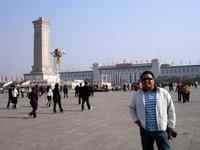 Tian’anmen Square (left) is said to be the largest city center square in the world. It is named after the Tian'anmen Gate (天安門) or Gate of Heavenly Peace. After taking photos at the (前門) Qianmen Gate (above right) which is at the southern end of the square and the Monument to the People's Heroes (人民英雄紀念碑), we proceeded to the (毛主席纪念堂) Chairman Mao Memorial Hall (below right) to view the remains of Mao Zedong.
Tian’anmen Square (left) is said to be the largest city center square in the world. It is named after the Tian'anmen Gate (天安門) or Gate of Heavenly Peace. After taking photos at the (前門) Qianmen Gate (above right) which is at the southern end of the square and the Monument to the People's Heroes (人民英雄紀念碑), we proceeded to the (毛主席纪念堂) Chairman Mao Memorial Hall (below right) to view the remains of Mao Zedong.The hall is a square building with 44 octagonal granite pillars. Outside the north and south entrances are two groups of statues 8.7 meters high. The building is solemn and grand with the remains of Chairman Mao enshrined in a crystal coffin in the reverence hall.
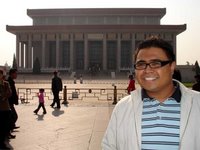 Just a note, you are not allowed to bring bags, more so cameras inside. So you could either ask a companion to wait outside and hold them for you or deposit them in the baggage storage center across the street for a fee. Entrance to the hall however is free. We made it in time since the hall was closing at 11:30 a.m.
Just a note, you are not allowed to bring bags, more so cameras inside. So you could either ask a companion to wait outside and hold them for you or deposit them in the baggage storage center across the street for a fee. Entrance to the hall however is free. We made it in time since the hall was closing at 11:30 a.m.After visiting the hall, and getting our bags back, we decided to walk around and look for a place to eat lunch. Along the way, we passed by the Beijing 2008 Olympics souvenir shop but didn't get to buy anything since everything was just so pricey!
 We found a Chinese fast food restaurant where I ordered this round pancake with pork inside which reminded me of murtabak. It was during lunch that Rhea and Marlon decided that they would take a train back to Guangzhou since plane tickets were RMB1,300 one-way. They did not buy tickets when we were at the station in the morning since they wanted to check out flight options. They just could not stand the long travel. But since plane tickets were more than twice the cost of the train, they opted for the latter. So we trooped back to the Beijing Train Station to get their tickets which were about RMB450. Now that the sun was out, we were also able to take photos in front of the train station.
We found a Chinese fast food restaurant where I ordered this round pancake with pork inside which reminded me of murtabak. It was during lunch that Rhea and Marlon decided that they would take a train back to Guangzhou since plane tickets were RMB1,300 one-way. They did not buy tickets when we were at the station in the morning since they wanted to check out flight options. They just could not stand the long travel. But since plane tickets were more than twice the cost of the train, they opted for the latter. So we trooped back to the Beijing Train Station to get their tickets which were about RMB450. Now that the sun was out, we were also able to take photos in front of the train station.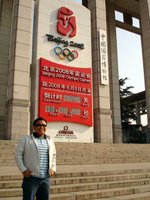 On the way to the subway station, we took photos in front of the Beijing 2008 Olympic Games countdown clock in front of the National Museum of China. The Games are opening at 8 p.m. of August 8, 2008 (8/8/08) since as you all know, "8" is a lucky number for the Chinese.
On the way to the subway station, we took photos in front of the Beijing 2008 Olympic Games countdown clock in front of the National Museum of China. The Games are opening at 8 p.m. of August 8, 2008 (8/8/08) since as you all know, "8" is a lucky number for the Chinese.I think we were able to troop back to Tian'anmen at 2 p.m. Since we were behind schedule, we rushed to take more photos. And one of them was in front of the Tian'anmen Gate itself, an image of Tian'anmen Square which is familiar all over the world.
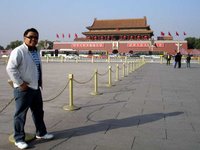 The 33.7 meter-high gate was the original entrance of the imperial city. And it's middle entrance was reserved for the emperor. It was from this gate that emperors announced their edicts.
The 33.7 meter-high gate was the original entrance of the imperial city. And it's middle entrance was reserved for the emperor. It was from this gate that emperors announced their edicts.With that done, it was time to fulfill my dream of stepping foot in the Forbidden City (紫禁城). Known as the Palace Museum (故宫), the Forbidden City was the residence of 24 emperors of the Ming and Qing Dynasties. It is among the UNESCO World Heritage sites in Beijing.
 Located in the center of the central axial line of Beijing, the imperial palace was first constructed in 1406. It has more than 9,000 palaces, halls and rooms, and contains a large number of valuable cultural relics. The entrance ticket to the palace was RMB40.
Located in the center of the central axial line of Beijing, the imperial palace was first constructed in 1406. It has more than 9,000 palaces, halls and rooms, and contains a large number of valuable cultural relics. The entrance ticket to the palace was RMB40.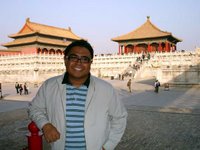 We were warned by our Chinese hosts that many of the structures would be covered by scaffolding since they were restoring the old buildings in time for the Beijing Olympics in 2008. It was good that the restoration work at the Temple of Heaven was already completed which is why if you notice in the photos, the colors of the structures were very vibrant. Some structures in the Forbidden City were also completed.
We were warned by our Chinese hosts that many of the structures would be covered by scaffolding since they were restoring the old buildings in time for the Beijing Olympics in 2008. It was good that the restoration work at the Temple of Heaven was already completed which is why if you notice in the photos, the colors of the structures were very vibrant. Some structures in the Forbidden City were also completed.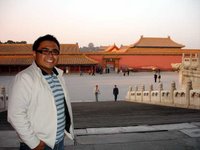 As we entered the gates of the main palace complex, I could hear the opening notes of "The Last Emperor" playing in my mind. But the sad part about our visit was the main hall of the palace was completely covered by scaffolding! There goes my photo with the main throne room.
As we entered the gates of the main palace complex, I could hear the opening notes of "The Last Emperor" playing in my mind. But the sad part about our visit was the main hall of the palace was completely covered by scaffolding! There goes my photo with the main throne room.You'd know if restoration on a structure was completed by the colors. The structures above have yet to be restored. While the one below is already done.
 We stayed until closing time, visiting as many sites as we could since the palace complex was just so vast. From the Palace Museum, we took a walk towards the southern end of Tian'anmen where there was an internet shop.
We stayed until closing time, visiting as many sites as we could since the palace complex was just so vast. From the Palace Museum, we took a walk towards the southern end of Tian'anmen where there was an internet shop.The regular internet shops are regulated by the government requiring ID cards before you could use them. This was to prevent minors from getting hooked to online gaming. But for tourist internet shops, they weren't too strict about IDs since the catch was the prices were sky high! They charged RMB20 per hour which was roughly PHP130.
Tomorrow we visit the Great Wall of China!

grabeh dami mo ng napuntahan. . saya life mo ah :)
ReplyDeleteayahmagat.blogspot.com
Just trying to visit as many places as I could while I'm young and able. :)
ReplyDeleteHi Ivan,
ReplyDeleteI am planning to go to Shanghai and Beijing early next year. How much more or less is the hotel accomodation? tnx
More Power to your Blog!
~ritziest~
We got a RMB230 a night room for the three of us. I'm not sure about Shanghai rates but they'll cost more for sure.
ReplyDelete